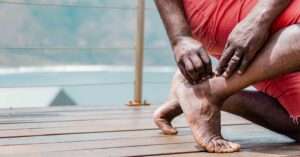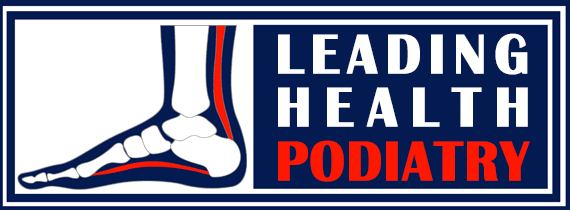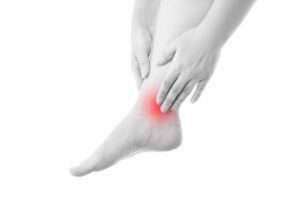Achilles Tendinopathy
Achilles tendonitis is a common condition that affects the Achilles tendon, which connects the calf muscles to the heel bone. It occurs when the tendon becomes inflamed, often due to overuse or strain. If left untreated, Achilles tendonitis can lead to chronic pain and mobility issues. At Leading Health Podiatry, we provide comprehensive care to diagnose, treat, and manage Achilles tendonitis, helping you regain pain-free movement.

What Causes Achilles Tendonitis?
Achilles tendonitis can develop due to various factors, including:
- Overuse: Repetitive activities like running, jumping, or sports that require sudden bursts of movement can put excessive strain on the Achilles tendon.
- Improper Footwear: Wearing shoes with inadequate support can increase stress on the Achilles tendon, leading to irritation.
- Tight Calf Muscles: Tightness in the calf muscles can cause extra strain on the Achilles tendon, contributing to inflammation.
- Sudden Increase in Activity: Rapidly increasing exercise intensity or duration can overload the Achilles tendon, resulting in tendonitis.
- Aging: As you age, the Achilles tendon loses elasticity, making it more prone to injury.
Symptoms of Achilles Tendonitis
The main symptoms of Achilles tendonitis include:
- Pain and Tenderness: Pain is typically felt along the back of the ankle or heel, especially after exercise or activity.
- Swelling: The Achilles tendon may appear swollen or inflamed.
- Stiffness: The tendon may feel stiff, especially in the morning or after long periods of rest.
- Limited Mobility: Achilles tendonitis can cause difficulty with walking, running, or performing physical activities.
- Pain with Pressure: Pressing on the tendon may increase pain or discomfort.
How We Diagnose Achilles Tendonitis
At Leading Health Podiatry, we take a thorough approach to diagnose Achilles tendonitis:
- Physical Examination: We assess your foot, ankle, and calf muscles to determine the severity of the inflammation and the source of the pain.
- Imaging Tests: X-rays or ultrasound may be used to evaluate the condition of the Achilles tendon and rule out other potential issues, such as tendon rupture.
- Gait Analysis: We observe your walking pattern to identify any biomechanical issues that may be contributing to Achilles tendonitis.
Treatment for Achilles Tendonitis at Leading Health Podiatry
We offer a range of effective treatments to manage Achilles tendonitis and relieve pain:
- Rest and Ice: Resting the affected tendon and applying ice can help reduce swelling and provide temporary pain relief.
- Custom Orthotics: Custom orthotics can help reduce strain on the Achilles tendon by providing better foot alignment and support.
- Stretching and Strengthening Exercises: Targeted exercises help stretch the calf muscles and strengthen the Achilles tendon, promoting healing and preventing future injuries.
- Physical Therapy: Physical therapy can help restore mobility, improve strength, and reduce pain caused by Achilles tendonitis.
- Anti-inflammatory Medications: Non-steroidal anti-inflammatory drugs (NSAIDs) can help reduce swelling and pain in the Achilles tendon.
- Eccentric Loading: Eccentric strengthening exercises have been shown to help heal and strengthen the Achilles tendon, reducing pain and promoting recovery.
- Shockwave Therapy: For chronic cases of Achilles tendonitis, shockwave therapy can stimulate healing and reduce inflammation in the tendon.
- Surgical Options: In rare cases where conservative treatments don’t provide relief, surgery may be recommended to repair the damaged Achilles tendon.
Preventing Achilles Tendonitis
To avoid developing Achilles tendonitis or reduce the risk of recurrence, consider the following tips:
- Warm-Up Properly: Always warm up before physical activity to prepare your muscles and tendons for exercise.
- Wear Proper Footwear: Choose shoes with adequate arch support and cushioning to protect the Achilles tendon during activity.
- Avoid Overuse: Gradually increase the intensity of your workouts to avoid overloading the Achilles tendon.
- Stretch Regularly: Incorporate calf and Achilles tendon stretches into your routine to improve flexibility and reduce tension on the tendon.
- Strengthen the Calf Muscles: Regular strengthening exercises can help prevent strain on the Achilles tendon.
When to See a Podiatrist for Achilles Tendonitis
If you’re experiencing pain, swelling, or stiffness in your Achilles tendon that doesn’t improve with rest, it’s time to seek professional care. At Leading Health Podiatry, our team will assess your condition and recommend a personalized treatment plan to relieve your Achilles tendonitis and get you back on your feet.
Conclusion
Achilles tendonitis can significantly affect your daily life, but with the right care, it’s possible to manage and treat the condition effectively. At Leading Health Podiatry, we provide comprehensive treatments for Achilles tendonitis, including custom orthotics, stretching exercises, physical therapy, and more. Contact us today to schedule an appointment and start your recovery journey.

